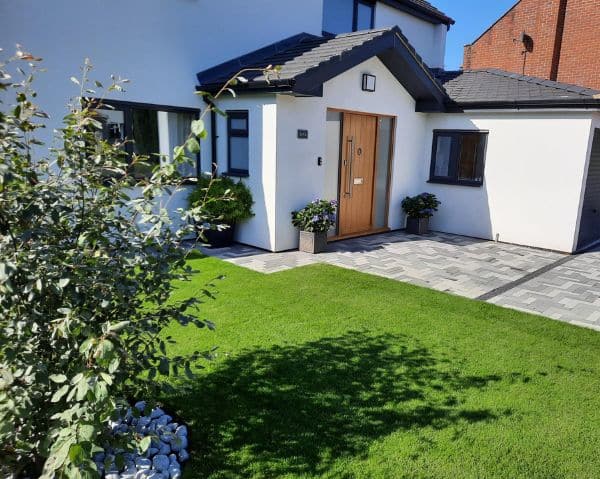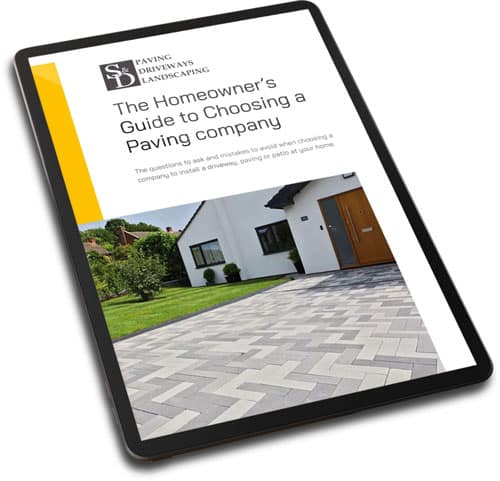Our Soft Landscaping Guide
A comprehensive landscape design incorporates soft and hard landscaping elements to create a cohesive, harmonious and accessible outdoor space.
As an award-winning paving and landscaping company, we understand that it is often the larger jobs within landscape design that take centre stage for our clients. Designing and installing paving, patios and driveways may be your main priority during a garden renovation, but it should not be the only one.
Using our years of experience and passion for landscape design, S&D Paving & Landscaping has developed this soft landscaping guide to remind our clients how important plants can be for your outdoor space.
We are going to share everything you need to know about soft landscaping in this guide, introduce plant options to suit all outdoor spaces, and provide maintenance tips to ensure your garden thrives in all seasons.
What is Soft Landscaping?
Soft landscaping is the general term to encompass all the living elements in your garden and outdoor spaces. Soft landscaping focuses on plants, flowers, trees and turf compared to hardscaping which is paving, patios and other solid structures.
As we have mentioned, it often takes a beautiful balance of the two for a comprehensive landscape design. Soft landscaping elements can soften the look of a space, add colour and texture, and create a more welcoming environment for an overall greater appeal to your outdoor space.
The Benefits Of Soft Landscaping
While the main appeal of soft landscaping in any outdoor space is aesthetic, the benefits of these elements go far beyond just enhancing the attraction and visual appeal of your surroundings which will be addressed throughout this soft landscaping guide.
Incorporating plants and flowers into your outdoor space can transform a stark, paved area into a lively, inviting garden. Soft landscaping includes a range of elements, such as plants, trees and even turf, to add a touch of natural beauty to your environment, which is incomparable to any man-made structures or décor.
Having a garden full of greenery is not only aesthetically pleasing, but also exudes an aura of serenity that helps to connect people to nature. Spending more time around nature can offer a range of health and well-being benefits, such as reduced stress and better sleep. Soft landscaping in your garden allows you to experience these benefits from the comfort of your own home and on demand.
As well as offering benefits to people, soft landscaping also plays a huge role in protecting environmental health and can contribute to a greener future.
Plants play a crucial role in improving air quality by acting as natural air purifiers by removing harmful pollutants from the air and producing oxygen. With this natural ability, plants create a healthier environment for everyone simply by being present. Soft landscaping also plays a significant role in reducing soil erosion. By securing the soil with their roots, plants prevent it from being washed away during heavy rains or winds, keeping the space neat and safe in all conditions.
Green spaces also greatly benefit other forms of life by providing vital natural habitats for local wildlife, including important insects. With more soft landscaping across the region, greater conservation of biodiversity and the overall ecological balance can be experienced.
As you will learn in this soft landscaping guide, incorporating these elements is not just about making a space look good — it’s about creating a space that feels good too, and therefore shouldn’t be ignored when it comes to your latest landscape renovation.
Complimenting Hardscaping with Soft Landscaping Guide
At S&D Paving & Landscaping, we understand the importance of balancing hard and soft elements in your garden design to create a harmonious, appealing layout for your outdoor spaces. No landscape design is complete without the incorporation of soft landscaping elements and these can be used to compliment any hardscape surfaces or areas for a more appealing layout.
There are various ways that soft landscaping elements can compliment any hardscaping present in your landscape, which we are going to address in this soft landscaping guide. These include:
Colour Contrast
Distinctive, bright flowers add colour to your garden, which can create a compelling contrast against neutral paving stones and other hardscaping elements. This dramatic interaction turns your pathway or patio into a vibrant canvas, making it more interesting and visually striking for a completely unique landscape design.
Texture Variation
Smooth, hard surfaces of patios and walkways can appear rather monotonous, which is why soft landscaping can be so benefit for your outdoor space.
Much like how plants can add colour, integrating varying textures of leaves, flowers and shrubs can also transform these areas. With multiple textures and sizes, you are creating a more layered, appealing aesthetic for specific areas of your garden.
The mixture of hard and soft textures creates a tactile, visual harmony to enhance the appeal of your overall landscape and make it a more interesting space for people of all ages.
Seasonal Interest
A major advantage of including plant life in your landscaping is the element of change it brings with each passing season. While hardscaping elements remain constant and static, plants evolve and transform with the changing seasons.
Flowers, plants and trees will blossom in spring, flourish in summer, change colours in autumn, and provide intriguing silhouettes in winter so your garden is always an interesting spectacle.
Incorporating soft landscaping and the continual change they provide to your landscape creates year-round interest, keeping your garden fresh and appealing.
Framing and Focus
Plants can artfully be used to frame and emphasise focal points in your hardscape, making them more appealing and drawing attention to the best bits of your garden.
Whether it’s a stunning water feature, a comfortable seating area, or a picturesque koi pond, the right grouping of plants can draw the eye, heighten the visual impact, and create a cohesive, balanced look to the space to make it more appealing at all times of the year.
By softening hardscaping elements with flowers, plants and trees, you can create a more cohesive and attractive look to the garden as a whole.
Soft Landscaping Guide For All Gardens
Now that you understand the benefits of soft landscaping and how it can enhance the appeal of your garden, it is time to begin incorporating it into your landscape. Choosing the right plants is crucial for a successful garden transformation, and your needs may vary based on the kind of style you want.
This generic soft landscaping guide can be used to inform decisions across all kinds of landscapes and is a great starting point for those who want to incorporate some colour, texture and seasonal appal into their gardens for the first time.
Trees and Shrubs
Trees and shrubs can be a great addition to any kind of landscape, adding a dense foliage that brings vibrancy and texture to the space. There are many species of trees and shrubs that you may want to incorporate, with some top picks being:
- Ornamental Trees: Japanese Maple (Acer palmatum) or Flowering Cherry (Prunus serrulata) add height and structure to the landscape, offering a natural focal point the space for year-round appeal.
- Evergreen Shrubs: Boxwood (Buxus sempervirens) or Holly (Ilex aquifolium) provide year-round greenery to keep your garden vibrant and colourful.
Perennials
Perennials are a great way to add an instant pop of colour to your garden during the summer and they can return in following seasons. If you are renovating your outdoor space during the warmer seasons and need some colour, texture and scents to enhance appeal then the following are great options:
- Flowering Perennials: Lavender (Lavandula), Geraniums (Geranium spp.), and Hosta (Hosta spp.) offer long-lasting blooms and foliage for an instant appeal to the outdoor space.
- Grasses: Miscanthus (Miscanthus sinensis) and Blue Fescue (Festuca glauca) grasses add movement and texture to your hardscape environment and can deliver ongoing visual appeal to the landscape.
Annuals and Biennials
For those who want the appeal of soft landscaping without continuous maintenance and decision-making, annuals and biennials are a great option. These plants can return year after year, bringing colour and texture to your landscape each spring.
- Bedding Plants: Options such as Petunias (Petunia spp.), Marigolds (Tagetes spp.), and Pansies (Viola spp.) are perfect for seasonal displays and will bring an instant colour boost to your landscape, even if you have limited space for soft landscaping.
- Biennials: Foxglove (Digitalis purpurea) and Sweet William (Dianthus barbatus) provide colour in their second year and are a great option for a long-term plant.
Ground Cover
If you have a lot of paved areas in your garden, you can still incorporate soft landscaping elements for additional colour, texture and appeal. Some great options can deliver large areas of coverage and instant appeal, such as:
- Low-Growing Plants: Creeping Thyme (Thymus serpyllum) and Periwinkle (Vinca minor) cover large areas quickly, offering instant attraction to the garden even if it is completely hardscaped.
Conclusion
Soft landscaping is an essential component of any well-designed garden. By carefully selecting the right plants, you can create a beautiful, functional outdoor space. Soft landscaping can complement your hardscaping elements and enhance your overall landscape design when chosen well.
At S&D Paving & Landscaping, we pride ourselves on offering comprehensive landscaping services, including landscape design, paving and driveway construction. Whether you’re starting from scratch or looking to enhance your existing garden, our award-winning team is here to help.
Contact Us Today
Ready to take your garden to the next level? Contact us today to schedule a consultation and discover how we can transform your outdoor space into a lush, vibrant haven that offers year-round appeal.









